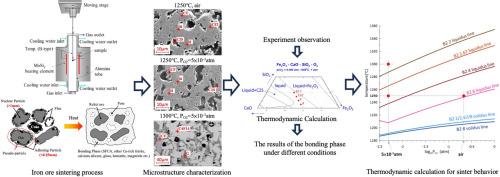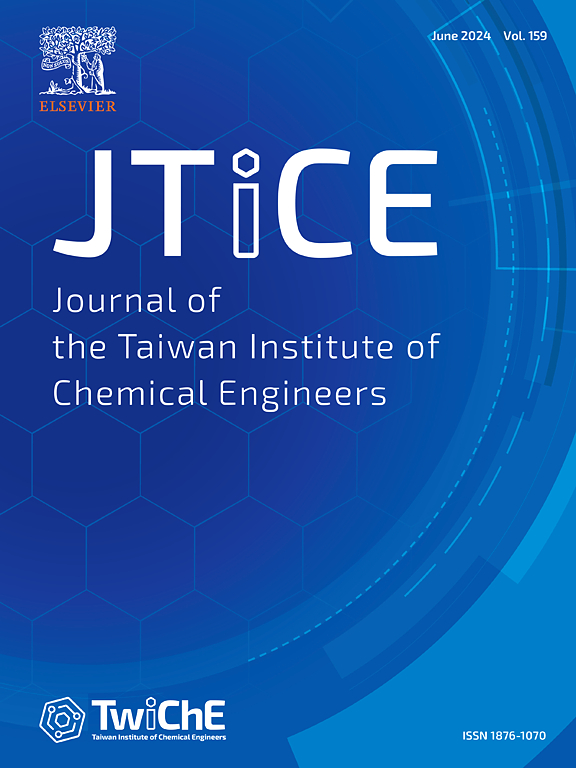低品位铁矿石对烧结反应的影响:快速加热实验和热力学建模
IF 5.5
3区 工程技术
Q1 ENGINEERING, CHEMICAL
Journal of the Taiwan Institute of Chemical Engineers
Pub Date : 2024-11-07
DOI:10.1016/j.jtice.2024.105817
引用次数: 0
摘要
背景烧结矿是高炉炼铁的主要原料。近来,烧结过程中含有大量煤矸石(主要是 SiO2)的低品位铁矿石的比例不断增加。本研究设计了一个快速加热炉来模拟烧结过程的实际热曲线。使用 X 射线衍射仪和扫描电子显微镜研究了烧结反应过程中碱度值、烧结温度和气氛对 Fe2O3-CaO-SiO2 三元混合物微观结构和相形成的影响。我们发现,固态反应在较低温度(1250 °C)下占主导地位,而液态辅助烧结则发生在较高温度(1300 °C)下。随着烧结矿中 SiO2 含量的增加,钙铁结合相的含量减少,而 Ca2SiO4 和 Fe2O3 的含量增加。关于气氛的作用,与环境气氛相比,在较低的氧分压下会形成更多的钙铁氧体结合相,这有利于 Fe2O3-CaO-SiO2 烧结矿的致密化。此外,还提出了低品位铁矿石烧结操作指南。本文章由计算机程序翻译,如有差异,请以英文原文为准。

Impact of low-grade iron ore on sintering reactions: Rapid heating experiments and thermodynamic modeling
Background
Sinter is a primary feedstock for blast furnace-based ironmaking. Recently, the proportion of low-grade iron ore, which contains a high amount of gangue (mainly SiO2), has been increasing in the sintering process. Therefore, the impact of increased SiO2 content on the quality of sinter needs to be clarified.
Methods
In this study, we designed a rapid-heating furnace to simulate the actual thermal profile of the sintering process. The effects of basicity values, sintering temperature, and atmosphere, on the microstructure and phase formation of the Fe2O3-CaO-SiO2 ternary mixtures during sintering reactions, are investigated using X-ray diffractometry and scanning electron microscopy. The experimental results are analyzed using CALPHAD-type computational thermodynamics.
Significant findings
We found that solid-state reactions dominate at the lower temperature of 1250 °C, while liquid-assisted sintering occurs at the higher temperature (1300 °C). As the SiO2 content in the sinter increases, the content of the calcium-ferrite bonding phase decreases, while the content of Ca2SiO4 and Fe2O3 increases. Regarding the role of the atmosphere, more calcium ferrite bonding phases form under a lower oxygen partial pressure compared to an ambient atmosphere, which facilitates the densification of the Fe2O3-CaO-SiO2 sinter. In addition, a guideline for sintering operation with low-grade iron ore is proposed.
求助全文
通过发布文献求助,成功后即可免费获取论文全文。
去求助
来源期刊
CiteScore
9.10
自引率
14.00%
发文量
362
审稿时长
35 days
期刊介绍:
Journal of the Taiwan Institute of Chemical Engineers (formerly known as Journal of the Chinese Institute of Chemical Engineers) publishes original works, from fundamental principles to practical applications, in the broad field of chemical engineering with special focus on three aspects: Chemical and Biomolecular Science and Technology, Energy and Environmental Science and Technology, and Materials Science and Technology. Authors should choose for their manuscript an appropriate aspect section and a few related classifications when submitting to the journal online.

 求助内容:
求助内容: 应助结果提醒方式:
应助结果提醒方式:


